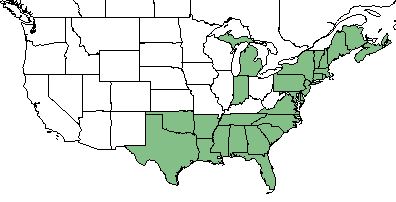Difference between revisions of "Utricularia radiata"
(→Taxonomic Notes) |
(→Taxonomic Notes) |
||
| Line 20: | Line 20: | ||
==Taxonomic Notes== | ==Taxonomic Notes== | ||
| − | Synonym: ''U. inflata'' var. ''minor'' Chapman | + | Synonym: ''U. inflata'' var. ''minor'' Chapman.<ref>Weakley, A.S. 2015. Flora of the southern and mid-atlantic states. Working Draf of 21 May 2015. University of North Carolina at Chapel Hill, Chapel Hill, North Carolina.</ref> |
==Description== <!-- Basic life history facts such as annual/perrenial, monoecious/dioecious, root morphology, seed type, etc. --> | ==Description== <!-- Basic life history facts such as annual/perrenial, monoecious/dioecious, root morphology, seed type, etc. --> | ||
Revision as of 17:38, 25 May 2021
| Utricularia radiata | |
|---|---|

| |
| Photo by Fred Nation hosted at Atlas of Florida Plants | |
| Scientific classification | |
| Kingdom: | Plantae |
| Division: | Magnoliophyta - Flowering plants |
| Class: | Magnoliopsida - Dicots |
| Order: | Scrophulariales |
| Family: | Lentibulariaceae |
| Genus: | Utricularia |
| Species: | U. radiata |
| Binomial name | |
| Utricularia radiata Small | |

| |
| Natural range of Utricularia radiata from USDA NRCS Plants Database. | |
Common Names: floating bladderwort; small swollen bladderwort;[1] little floating bladderwort[2]
Contents
[hide]Taxonomic Notes
Synonym: U. inflata var. minor Chapman.[3]
Description
Utricularia radiata is a dioecious annual or perennial that grows as a forb/herb.[2] It has inflated conspicuous petioles and floats suspended on top of water[4] or submersed.[5] This species reproduces sexually and by fragmentation. It produces winter buds/turions and has an unrooted growth form.[6] Its size ranges from 0-1 ft (0-30.5 cm) and flowers are yellow and 0.5 in (1.27 cm).[7] Seedlings lack cotyledons.[8]
Distribution
This species occurs from Nova Scotia, New Brunswick, and Maine, southward to southern Florida, westward to Texas, and disjunct in western Virginia, western Tennessee, and northwestern Indiana. Reports of it occurring in Cuba and South America are in error according to Weakley.[1] Disjunct populations are also reported in southwestern Michigan.[9]
Ecology
Habitat
U. radiata occurs in ponds, depression ponds, lakes, and ditches.[1] In Nova Scotia, it typically grows in 1-3 m deep water and is associated with Brasenia shreberi.[10]
Phenology
In the southeastern and mid-Atlantic United States, U. radiata flowers from may through November.[1]
Use by animals
As a carnivorous bladderwort, Utricularia species can prey upon a range of zooplankton and phytoplankton, including copepoda, ostracoda, Cladocera, Chironomidae,[11] diatoms (Bacillariophyceae), green algae (Charophyceae, Chlorophyceae), dinoflagellates (Dinophyceae), flagellates (Euglenophyceae), and Cyanobacteria.[12] This can include larval parasitic blood flukes (i.e. Schistosoma mansoni) which creates the possibility of U. radiata being used to reduce parasite densities in endemic areas.[13]
Conservation and Management
Cultivation and restoration
Photo Gallery
References and notes
- ↑ Jump up to: 1.0 1.1 1.2 1.3 Weakley AS (2015) Flora of the Southern and Mid-Atlantic States. Chapel Hill, NC: University of North Carolina Herbarium.
- ↑ Jump up to: 2.0 2.1 USDA NRCS (2016) The PLANTS Database (http://plants.usda.gov, 15 February 2018). National Plant Data Team, Greensboro, NC 27401-4901 USA.
- Jump up ↑ Weakley, A.S. 2015. Flora of the southern and mid-atlantic states. Working Draf of 21 May 2015. University of North Carolina at Chapel Hill, Chapel Hill, North Carolina.
- Jump up ↑ Further notes on coastal floral elements in the bogs of Augusta County, Virginia. Rhodora 42(495):86-93.
- Jump up ↑ Reinert GW, Godfrey RK (1962) Reappraisal of Utricularia inflata and U. radiata (Lentibulariaceae). American Journal of Botany 49(3):213-220.
- Jump up ↑ Capers RS, Selsky R, Bugbee GJ (2009) The relative importance of local conditions and regional processes in structuring aquatic plant communities. Freshwater Biology 55(5):952-966.
- Jump up ↑ Plant database: Utricularia radiata. (15 February 2018) Lady Bird Johnson Wildflower Center. URL: https://www.wildflower.org/plants/result.php?id_plant=UTRA
- Jump up ↑ Kondo K, Segawa M, Nehire K (1978) Anatomical studies on seeds and seedlings of some Utricularia (Lentibulariaceae). Brittonia 30(1):89-95.
- Jump up ↑ Reznicek AA (1994) The disjunct coastal plain flora in the great lakes region. Biological Conservation 68:203-215.
- Jump up ↑ Hill NM, Boates JS, Elderkin MF (2000) Low catchment area lakes: New records for rare coastal plain shrubs and Utricularia species in Nova Scotia 102(912):518-522.
- Jump up ↑ Andrikovics S, Forro L, Zsunics E (1988) the zoogenic food composition of Utricularia vulgaris in the Lake Ferto. Opuscula Zoologica 23:65-70.
- Jump up ↑ Alkhalaf IA, Hubener T, Porembski S (2009) Prey spectra of aquatic Utricularia species (Lentibulariaceae) in northeastern Germany: The role of planktonic algae. Flora 204:700-708.
- Jump up ↑ Gibson M, Warren KS (1970) Capture of Schistosoma mansoni Miracidia and Cercariae by carnivorous aquatic vascular plants of the genus Utricularia. Bulletin of the World Health Organization 42(5):833-836.